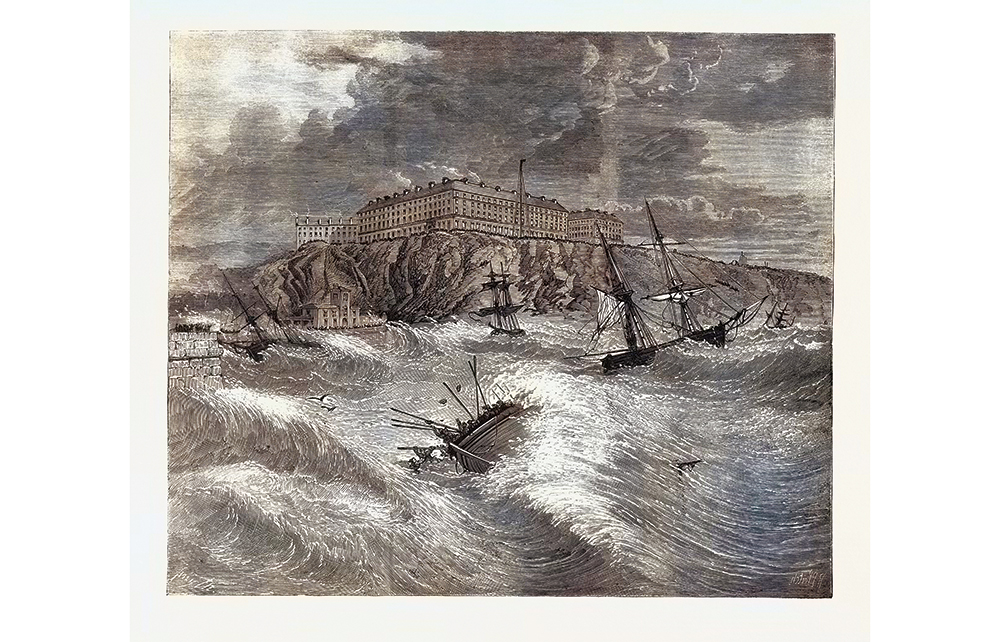Our summer holidays by the sea were the thrill of the year and the lifeboat was the thrill the holidays. Whissh-crack! went the maroon, sending the dauntless crew and their punchy little vessel off into the waves to save souls. The Royal National Lifeboat Institution has been doing this for 200 years. Mariners and all of us must hope it never stops, because its story is the best of us.
In One Crew, Helen Doe, a maritime historian, writes the official history with verve and precision. She explains that there were 39 lifeboats operating independently around the coast, ‘enjoying varying degrees of effectiveness’, before Sir William Hillary, a ‘bankrupt baron’ self-exiled to the Isle of Man, founded the Royal National Institution of the Preservation of Life from Shipwreck – branding, like public relations, lifejackets and self-righting boats, being in its infancy.
A helicopter pilot described the 1981 Penlee rescue attempt as ‘the greatest act of courage I am ever likely to see’
The institution would advance them all. From 1823, Hillary, ‘a man of impulsive and brave action’, began setting up a chain of lifeboats helmed by expert seamen, funded by donations from across society. The money would also support the widows and children of men who would die in service. More than 800 have. ‘The people of vessels of every nation, whether in peace or war, are to be equally objects of this institution; and the efforts made to be in all cases the same as for British subjects and British vessels’ was Hillary’s principle, tested during wartime, when the RNLI saved thousands, and recently, during the Channel boats crisis.
Hillary himself led a crew which in 1828 rescued 62 people from three foundering ships. Readers’ eyes will widen at quite how indomitable rescuers were and are; volunteering for what in 1854 became the RNLI demands heroism of entire communities. One winter night in 1899 gales in the Bristol Channel trapped the Lynmouth lifeboat in harbour. A sailing ship was in trouble, so 100 men and women hauled their ten-ton boat 13 miles overland, widening roads, knocking down walls, harnessing 18 horses to get it up Countisbury and down Porlock Hill, two of the steepest in England, to launch from Porlock.
There are many disasters here, from capsizes, men perishing within sight of people and their homes, overrun by monstrous seas, to the tragedy of the Penlee lifeboat in 1981 in Cornwall. The crew refused to abort even as giant swells dumped their vessel on top of the ship they were trying to help. A coastguard helicopter pilot described it as ‘the greatest act of courage that I am ever likely to see’. These are astounding stories, scrupulously researched and deftly told. Imagine launching, as the crew of Ballycotton, Co. Cork, did in February 1936, when the sea is breaking over your lifeboat station, and will crash over your boat for the next 49 hours. In 1914 a huge wave dashed the Fethard lifeboat at Wexford on to rocks, killing nine of the crew. The remaining five pulled shipwrecked Norwegians to an island where they all huddled for three days, one man dying of exposure. The last survivors were saved by two Wexford men rowing a holed skiff, the hole plugged with a loaf of bread wrapped in oilskins.
You can still be saved by an Irish crew wearing flags of their royal charter, partly because Andrew Jameson, trusted by both sides during the war of independence, was also the chairman of the RNLI in Ireland. Crews’ loyalty to their roles and the institution transcends politics in Ireland to this day.
Along with great men, great women and children become increasingly present in Doe’s story. Britain’s first charity street collection, in aid of the widows and orphans of crews, raised more than £4,600 in Manchester in 1891, the collection boxes overseen by boys from the Strangeways Refuge. The youngest rescuer honoured by the RNLI is Richard Bowden, 13, who rowed his dingy, crewed by two toddlers, to save a girl off Appledore, Devon in 1961.
The book is often very moving. ‘Women have been the backbone of the institution since the early days,’ Doe writes, and she tells of the loss of the Longhope lifeboat which went to the aid of a Liberian freighter in 100ft walls of water in the Pentland Firth in 1969. Seven women were widowed and eight children lost their fathers, but what struck the inspector of lifeboats when he visited Longhope ‘to try to find something to say’ was that every widow first wanted to know what had happened to the Liberian crew, who had run safely aground. Doe demonstrates that without the mighty fundraising efforts of women, and their crewing and captaincy of lifeboats, which began in 1969 at the station where I later volunteered, Atlantic College, the RNLI would have foundered. Instead it has become a model and mentor to lifesaving services around the world.
It says much about us and our RNLI that one of the lowest points of British politics, the nationally shaming spectacle of the hard right denouncing lifeboats for ‘acting like a taxi service for migrants’, was answered by record-breaking donations from across Britain and Ireland, an episode Doe skirts.
But generosity of purse, body and soul are everywhere in this scrupulous and gripping history. When I asked the RNLI if I might join them in the Channel to report their rescues, a spokesperson said they could not spare deck space. ‘Sometimes we’re so busy we don’t even count them,’ she confided. How proud this would make Hillary, whose last wish was that ‘every stranger, whom the disaster of the sea may cast on her shores, should never look for refuge in vain’.






Comments